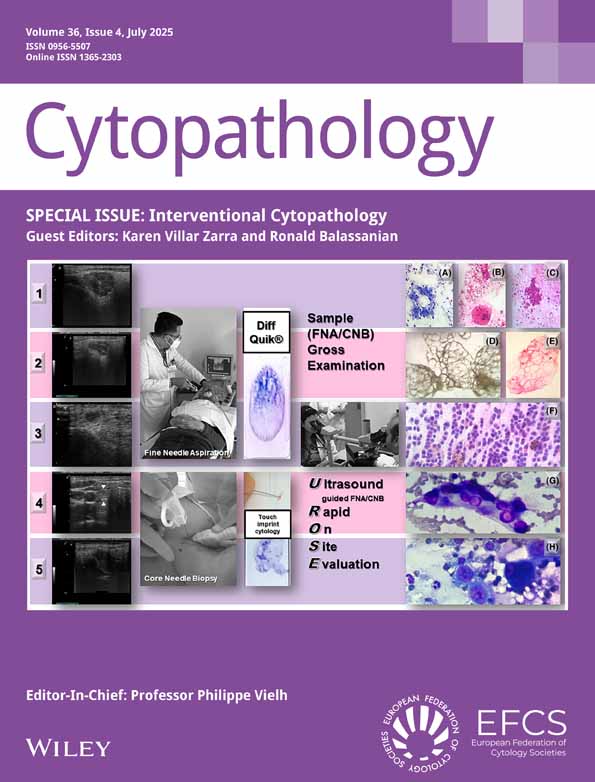Diagnostic associations of p53 immunostaining in fine needle aspiration cytology of the breast
Abstract
enDuplicate cytospin preparations were made from 46 symptomatic breast fine needle aspirates. One of each pair was assigned to benign or malignant categories by one experienced observer as part of the ‘triple approach’patient assessment. the other was immunostained with DO7, a monoclonal antibody to recombinant p53 protein, and rated by another observer as positive or negative for nuclear staining, unaware of the cytodiagnosis. Positive controls included carcinomas known to have mutant p53, while negative controls were of the reagent substitution type. of the 26 aspirates with a benign cytodiagnosis (verified by the triple approach), 23 were p53 protein-negative and three positive. of the 20 with a malignant cytodiagnosis (histologically confirmed), six were p53 protein-negative and 14 positive (exact P<0.0001). As a diagnostic test this would give 70% sensitivity and 88% specificity.
Abstract
frDans 46 cas de cytoponctions mammaires les préparations par cytocentrifugation ont été dupliquées. L'une des lames est examinée par un observateur expérimenté, pour le diagnostic bénin/malin, dans le cadre du ‘triplet diagnostic’. L'autre préparation fait l'objet d'un immunomarquage avec l'anticorps DO7, anticorps monoclonal dirigé contre une protéine p53 mutée. Le marquage nucléaire a été classé positif ou négatif par un deuxième observateur, indépendamment du diagnostic. Les contrôles positifs ont utilisé des carcinomes connus pour protéine p53 mutée, alors que les contrôles négatifs sont de type omission de réactifs. Sur les 26 ponctions classées bénignes (contrôlées par le triplet), 23 étaient négatives et 3 positives. Sur les 20 cas malins (confirmés histologiquement), 6 étaient p53 négatifs et 14 positifs (P<0,0001—valeur exacte). Si la positivité p53 était utilisée comme test diagnostique, la sensibilité serait de 70% et la spécificite de 88%.
Abstract
deZwei Cytospinpräparate wurden von 46 symptomatischen Feinnadelpunktaten der Brust hergestellt. Jeweils 1 Präparat wurde im Rahmen der Triplediagnostik durch einen erfahrenen Gutachter in die Kategorie bösartig oder gutartig eingeordnet. Das 2. Präparat wurde mit dem monoklonalen Antikörper DO7 gegen rekombinantes p53 Protein gefärbt und durch einen unabhängigen Gutachter getrennt ausgewertet. Von 26 als gutartig eingestuften Präparaten waren 23 p53 negativ und 3 positiv, von den 20 als maligne eingestuften und histologisch bestätigten Präparaten waren 6 p53 negativ und 15 positiv (P<0.0001). Die Sensitivität des Testes beträgt somit 70%, die Spezifität 88%.




